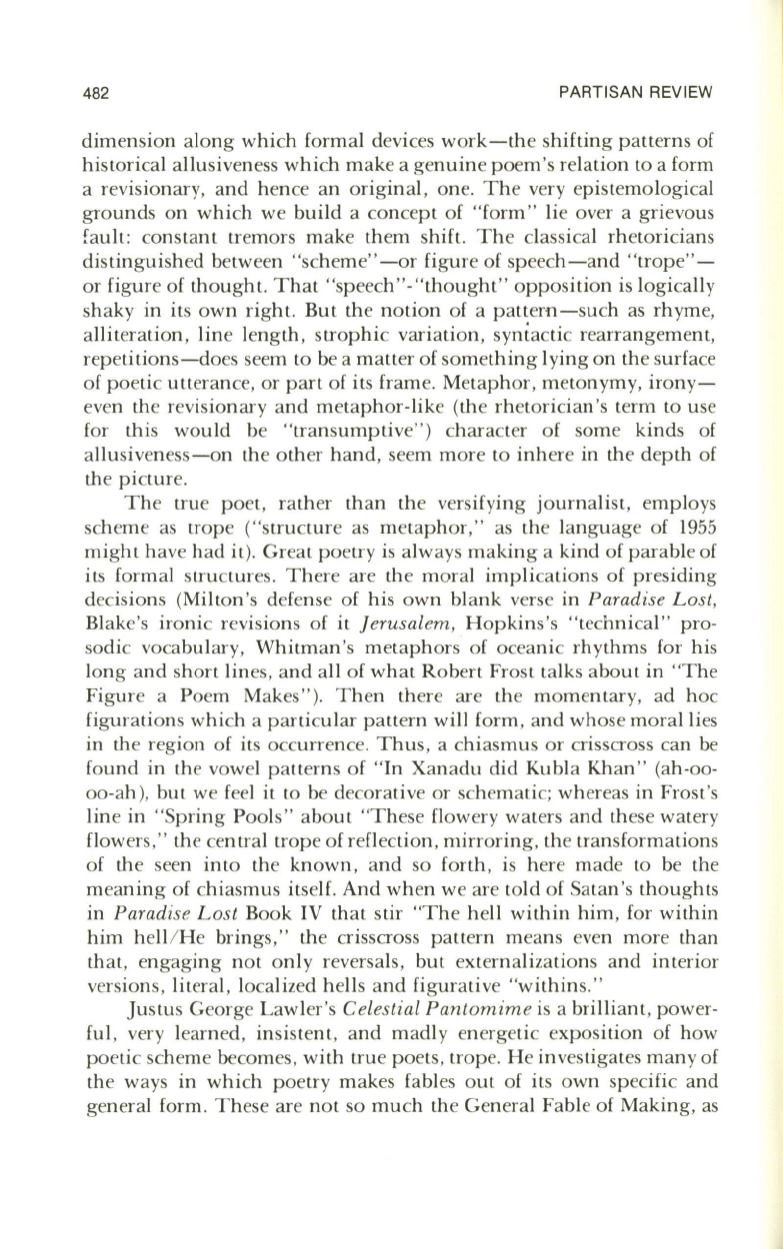
482
PARTISAN REVIEW
dimension along which formal devices work-the shifting patterns of
historical allusiveness which make a genuine poem's relation to a form
a revisionary, and hence an original, one. The very epistemological
grounds on which we build a concept of "form" lie over a grievous
fault: constant tremors make them shift. The classical rhetoricians
distinguished between "scheme" -or figure of speech -and "trope"–
or figure of thought. That "speech"-"thought" opposition is logically
shaky in its own right. But the notion of a pattern-such as rhyme,
alliteration, line length, strophic variation, syntactic rearrangement,
repetitions-does seem to be a matter of something lying on the surface
of poetic utterance, or part of its frame. Metaphor, metonymy, irony–
even the revisionary and metaphor-like (the rhetorician's term to use
for this would be "transumptive") character of some kinds of
allusiveness-on the other hand, seem more to inhere in the depth of
the picture.
The true poet, rather than the versifying journalist, employs
scheme as trope ("structure as metaphor," as the language of 1955
migh t have had it). Great poetry is always making a kind of parable of
its formal structures. There are the moral implications of presiding
decisions (Milton's defense of his own blank verse in
Paradise Lost,
Blake's ironic revisions of it
Jerusalem,
Hopkins's "technical" pro–
sodic vocabulary, Whitman's metaphors of oceanic rhythms for his
long and short lines, and all of what Robert Frost talks about in "The
Figure a Poem Makes"). Then there are the momentary, ad hoc
figurations which a particular pattern will form, and whose moral lies
in the region of its occurrence. Thus, a chiasmus or crisscross can be
found in the vowel patterns of "In Xanadu did Kubla Khan" (ah-oo–
oo-ah), but we feel it to be decorative or schematic; whereas in Frost's
line in "Spring Pools" about "These flowery waters and these watery
flowers," the central trope of reflection, mirroring, the transformations
of the seen into the known, and so forth, is here made to be the
meaning of chiasmus itself. And when we are told of Satan's thoughts
in
Paradise Lost
Book IV that stir "The hell within him, for within
him hell / He brings," the crisscross pattern means even more than
that, engaging not only reversals, but externalizations and interior
versions , literal, localized hells and figurati ve "withins."
Justus George Lawler's
Celestial Pantomime
is a brilliant, power–
ful, very learned, insistent, and madly energetic exposition of how
poetic scheme becomes, with true poets, trope. He investigates many of
the ways in which poetry makes fables out of its own specific and
general form. These are not so much the General Fable of Making, as


